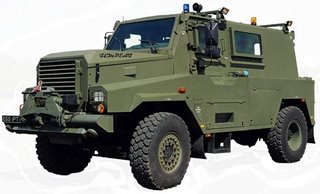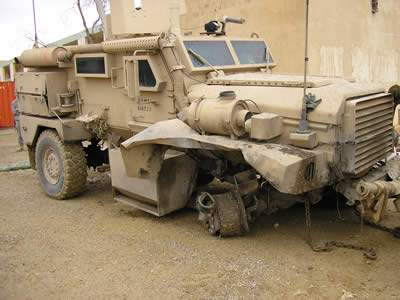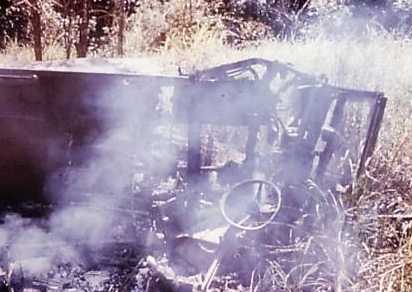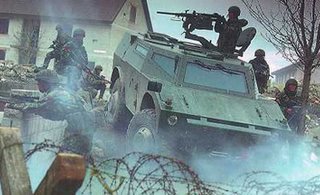
Following my post on Sunday on How Blair is killing our soldiers, the story – if at all possible – gets murkier and murkier. Before proceeding, however, I must thank all those website and blog owners who linked to the piece and the many readers who responded and are taking action. I will keep you abreast of the responses they receive.
And so to the story as we left it on Sunday, with an account of how Lord Drayson, the defence procurement minister, on 12 June this year had dismissed the idea of buying the mine protected RG-31s to replace the "Snatch" Land Rover. Not only did he assert that the "Snatch" provided us "with the mobility and level of protection that we need", he informed the House of Lords that:
We had 14 RG-31s in Bosnia, which we took out of service some time ago due to difficulties with maintenance. We have looked at the RG-31 alongside a number of alternatives for our current fleet and concluded that the size and profile did not meet our needs. Size is important in the urban environment. The RG-31 cannot access areas that Snatch Land Rovers can get to.According to the minister, therefore – and there can be no other construction from his words – the RG-31s were basically too large for the "urban environment", hence the choice of the smaller Land Rovers.
Well, as it happens, we have found a photograph of the "RG-31s" used by the British Army in Bosnia, which is reproduced at the top of this post. In fact, they were not RG-31s but Mambas, an earlier version of the vehicle – and even then they were not the standard body. They were, in fact, a rare, short-wheel-base version, variously known as the "Commanche" or "Acorn", converted by Alvis PLC, the British owner of the South African manufacturer. You can judge for yourself from the photograph how much of a handicap the size of these vehicles might be.
However, since "the size profile" did not meet the MoD needs, it was decided to replace the vehicles and, around 2002, an alternative vehicle was in the process of being procured. We know this because there was a Parliamentary Question on 5 February 2002 by Mike Hancock, Lib-Dem MP for Portsmouth South, from which we learn that the replacement was called a "Tempest". These were to be used for:
...casualty evacuation and route proving operations where mines are present and provide high levels of protection from anti-tank/personnel mine blasts.Dr Moonie, who answered the question, was extremely reticent about the price, withholding information "in accordance with Exemption 7a(2) of the Code of Practice on Access to Government Information, which relates to information whose disclosure would prejudice commercial or contractual activities."
 Anyhow, we also managed to find a photograph of the Tempest (left)and some details from the Royal Engineers website. Known officially as "Truck, Mine Protected Vehicle" (MPV), as readers will discern from the picture, this is based on the chassis of an articulated truck. The Royal Engineers describe it thus:
Anyhow, we also managed to find a photograph of the Tempest (left)and some details from the Royal Engineers website. Known officially as "Truck, Mine Protected Vehicle" (MPV), as readers will discern from the picture, this is based on the chassis of an articulated truck. The Royal Engineers describe it thus:The MPV, formerly known as Project TEMPEST. The planned role of the MPV is route proving and casualty evacuation (CASEVAC). The donor platform for the cab and chassis services is the Peterbilt 330 articulated tractor unit. The front and forward rear axles were removed and replaced by a Marmon Herrington 4 Drive conversion. MPV is a modified Commercial Off the Shelf (COTS) equipment procured against an Urgent Operational Requirement (UOR) and replaces the MAMBA vehicle fleet of the mine protected vehicles. The vehicles were assembled by Technical Solutions Group in the USA with the UK EOD specific requirements incorporated by Supacat Ltd.
 Thus we see the MoD, having decided that the Mambas were too big, decided to replace them – at unspecified expense – with a truck at least four times the size, buying fewer of them into the bargain, for use in exactly the same role. And so desperate was their need that they bypassed the normal competitive contract process and acquired the equipment against an "Urgent Operational Requirement".
Thus we see the MoD, having decided that the Mambas were too big, decided to replace them – at unspecified expense – with a truck at least four times the size, buying fewer of them into the bargain, for use in exactly the same role. And so desperate was their need that they bypassed the normal competitive contract process and acquired the equipment against an "Urgent Operational Requirement".Now it begins to get interesting, and not a little murky as we follow two separate threads.
First, we follow Technical Solutions Group. It is owned by a US company, Force Protection Inc, which currently manufactures a range of mine protected vehicles for the US Army and Marine Corps. More of this company later but what is most interesting at this stage is one particular member of the management team, a certain Murray Hammick (below left), who joined the company on 12 February 2004.
 Although on the company website as late as 6 June this year, he has suddenly disappeared from the line-up. But, through the marvels of the Google cache system, his details are still accessible, and fascinating reading they make. As "Vice President, Integrated Logistics Support":
Although on the company website as late as 6 June this year, he has suddenly disappeared from the line-up. But, through the marvels of the Google cache system, his details are still accessible, and fascinating reading they make. As "Vice President, Integrated Logistics Support":Before joining Force Protection, Murray Hammick owned and managed UK-based Seafire Ltd., developers of specialist military vehicles; he was centrally involved in the 2001 sale of the Tempest MPV to the UK MOD. He was head of business development for UK defense contractor Alvis Vehicles Ltd, handling sales, marketing and new product development roles involving the UK MOD, US DOD, NATO, and the UN. He set up and managed the first international transfer of mine-protection technology out of South Africa covering the Mamba series of MPVs, and was ground forces editor for Jane's International Defense Review from 1990-93.From a separate website, we also see that Hammick's job was to oversee and co-ordinate all projects at both Force Protection and its wholly owned subsidiary, Technical Solutions Group, reporting directly to Michael Watts, the Company's then CEO.
Mr. Hammick is a retired British Army major. He served over 24 years in regular and reserve armored and airborne units and ran armor anti/armor research trials. Mr. Hammick holds a bachelor of science degree, and formal qualifications in military design & technology.
We also learn from this website that Hammick not only won the contract to sell MPVs to the British Army but, while working for Alvis, had been appointed Product Manager, responsible for developing two armored vehicles and one Special Forces vehicle. He subsequently established Seafire Limited and went on to win a number of contracts, including some in partnership with TSG and Supacat.
What this demonstrates is that the very technology that went into the Mamba and subsequently the RG-31 was exploited by Hammick and used in the production of the Tempest, for which the British taxpayer paid a no doubt handsome – if unspecified - price. We also know that, armed with the knowledge of that design and the experience of having built the vehicle, Hammick joins Force Protection.
With that under our belts, let us now follow the second thread – the Tempest itself. A search for information on this vehicle eventually leads you to this site, a general site on "vehicle protection". However, it does have an entry for the Technical Solutions Group (TSG), under which is an active link marked "Tempest". When you click that, you arrive here.
 Surprisingly, there is no mention at all of the Tempest. The page is headed "Cougar", a mine protected vehicle made by none other than Force Protection Inc. Furthermore, helpfully, there is a picture of the Cougar (right). As you will see, for all intents and purposes, the Cougar is the Tempest, designed and paid for by the British taxpayer and handed on a plate to the American company by Mr Hammick.
Surprisingly, there is no mention at all of the Tempest. The page is headed "Cougar", a mine protected vehicle made by none other than Force Protection Inc. Furthermore, helpfully, there is a picture of the Cougar (right). As you will see, for all intents and purposes, the Cougar is the Tempest, designed and paid for by the British taxpayer and handed on a plate to the American company by Mr Hammick.Force Protection is doing very well out of the deal. Not only has it already sold a considerable number of Cougars to the US forces, it has teamed up with none other than our very own BAE Systems to produce a variant called the Iraqi Light Armoured Vehicle, acquiring a recent contract from the US Army worth $180 million for 378 models, which could increase to $445.4 million for 1,050 vehicles, if all options are exercised.
From all accounts, the money will be well-spent. The USMC who already have the equipment, speak very highly of it. In addition, one crew gave written testimony to Force Protection of how it had undoubtedly saved their lives:

Just wanted to write a quick note to all of you at your company to thank you for the hard work you put into the Cougar vehicle. We are stationed in [omitted] Iraq and about 2 weeks ago our JERRV Cougar ran over [deleted] mine coming back from a call downtown. It had been raining that night and the mines were placed in a hole filled with water. Right after the explosion, the Cougar was driven for two miles on the three remaining tires at speeds in excess of 20 mph so that we could make it to a safe area.If that does not tell the story, the photograph (above) provides adequate evidence of the life-saving capability of this remarkable machine. And, unlike the RG-31s where, since their introduction, three vehicles have been destroyed by IEDs and enemy action, with five fatalities, as of June 2006, with more than 130 Cougars and the similar Buffalos in Afghanistan and Iraq, the vehicles have taken about 1,000 IED hits without a loss of life.
Once we got to the safe area we were able to survey the damage and everyone was amazed how far the vehicle had driven. The three of us inside were all okay other than slight concussions and a headache that lasted a few days. We know that if we had been in another type of vehicle that the outcome would have been much worse. We were also able to get a replacement Cougar within 24 hours. Thank you for everything and keep up the good work.
So far, therefore, we see a life-saving vehicle, designed and developed at the expense of the British taxpayer, being successfully introduced into the US forces, while our own defence procurement minister declares that a much smaller vehicle, based on the same technology, is far too big for our troops. They must continue to use lightly armoured "Snatch" Land Rovers. Of the eight Tempests still presumably in service in the British Army, we know nothing of their whereabouts.
 Incidentally, when researching for what amounts to the first part of this story, I was puzzled by the absence of photographs of Land Rovers that had been hit directly by IEDs. I have since found one from a different conflict and can now see why. After a hit, there is often nothing left but smouldering wreckage, barely recognisable as a vehicle – compare and contrast (above right) with the picture of the Cougar above.
Incidentally, when researching for what amounts to the first part of this story, I was puzzled by the absence of photographs of Land Rovers that had been hit directly by IEDs. I have since found one from a different conflict and can now see why. After a hit, there is often nothing left but smouldering wreckage, barely recognisable as a vehicle – compare and contrast (above right) with the picture of the Cougar above.Even with this, though, the story does not end. To complete the saga we must go back to the British Army Mambas in Bosnia – those which the MoD was so eager to dispose of.
 While in the Balkans, the Army came across a new and more deadly type of mine – the TMRP-6 "shaped charge" mine - for which the Mambas provided no defence. A South African technology company therefore was commissioned to design counter-measures which were applied to the Mambas.
While in the Balkans, the Army came across a new and more deadly type of mine – the TMRP-6 "shaped charge" mine - for which the Mambas provided no defence. A South African technology company therefore was commissioned to design counter-measures which were applied to the Mambas.The lessons learned, however, did not stop there. Applying them and the technology that went into the RG-31, Alvis PLC set about building as a private venture a brand new, state-of-the art armoured patrol/ reconnaissance vehicle which emerged as the Scarab (above, left).
This vehicle was then offered to the MoD in the 2001 competition for the Army's Future Command and Liaison Vehicle (FCLV), alongside the RG-31 and its smaller brother, the RG32M and the Fench-designed ACMAT. We covered this competition extensively in earlier posts, here, here and here. Without revisiting all the details, suffice it to say that the MoD introduced another vehicle to the competition, the Italian-built Iveco Panther (below, right), after the shortlist had been closed in breach of its own rules. It then went on to select it as the winner, paying £166 million for 401 vehicles, equating to £413,000 each.
 And, as we now know, the MoD civil servant who was "the only person to have been intimately involved in this programme from initiation to contract award," a Mr Andrew Simpson of Bath, now works as a consultant for the Italian manufacturer.
And, as we now know, the MoD civil servant who was "the only person to have been intimately involved in this programme from initiation to contract award," a Mr Andrew Simpson of Bath, now works as a consultant for the Italian manufacturer.Although a mine-protected vehicle in its own right, it is unlikely that Mr Simpson's Panther was any match for the Scarab – which has since disappeared after Alvis was taken over by BAE Systems. It is now marketing the Panther after it had been awarded the MoD contract for it.
While the Scarab, in its patrol or reconnaissance configuration, could have provided a valuable additional tool in both Iraq and Afghanistan – and given state-of-the-art protection - the Panther, barely if at all adequate as a command/liaison vehicle, would make a poor patrol vehicle. Not that the troops are likely to be given the opportunity to try it out. It is designated for the medium armoured brigades which are to form the heart of the British contribution to the European Rapid Reaction Force, in which Tony Blair has invested so much political capital.
With the money spent on this and other extravaganzas, there is no money left in the defence budget for new kit. British troops must make do with their lightly armoured "Snatch" Land Rovers. The US troops, on the other hand, can enjoy the comfort and security of their Cougars, designed and developed at British taxpayers' expense. But hey! What price soldiers' lives when European defence integration beckons?
COMMENT THREAD